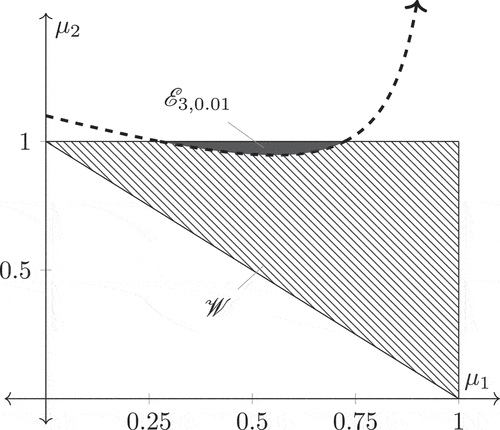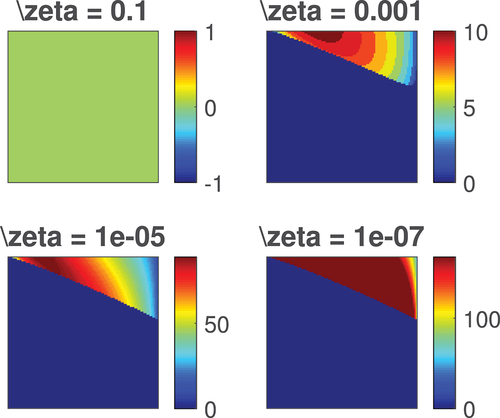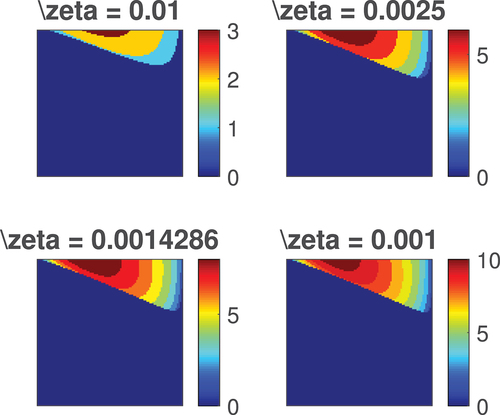 ?Mathematical formulae have been encoded as MathML and are displayed in this HTML version using MathJax in order to improve their display. Uncheck the box to turn MathJax off. This feature requires Javascript. Click on a formula to zoom.
?Mathematical formulae have been encoded as MathML and are displayed in this HTML version using MathJax in order to improve their display. Uncheck the box to turn MathJax off. This feature requires Javascript. Click on a formula to zoom.ABSTRACT
In this study, the sequential operator of mixed order is analysed on the domain with
. Then, the positivity of the nabla operator is obtained analytically on a finite time scale under some conditions. As a consequence, our analytical results are introduced on a set, named
, on which the monotonicity analysis is obtained. Due to the complicatedness of the set
several numerical simulations so are applied to estimate the structure of this set and they are provided by means of heat maps.
1. Introduction
Theoretical and applied discrete fractional calculus have been widely employed in many fields such as engineering, astronomy, physics, biology, economics, computer science, and other domains, as described in the published articles (Atici and Eloe Citation2008; Wu and Baleanu Citation2015; Gholami and Ghanbari Citation2016; Baleanu et al. Citation2017; Mozyrska et al. Citation2019). In recent years, many researchers have introduced fractional sums and difference operators with new kernels including fractional Riemann-Liouville, Liouville-Caputo, AB, CF difference operators (cf. Goodrich and Peterson Citation2015; Abdeljawad Citation2018; Mohammed and Abdeljawad Citation2023).
In many branches relying upon fractional difference operators, the positivity and monotonicity analyses with or without some initial conditions are abundantly applied. Positivity and monotonicity analyses have proven to be useful tools with a wide variety of applications in the mathematical analysis. Among them, they have been applied to determine the existence and uniqueness of fractional difference models, and to determine a function to be increasing or decreasing. Analysing fractional difference problems involves a distinct set of challenges and techniques until we get the positivity of the delta or nabla function for all of the fractional Riemann-Liouville, Liouville-Caputo, AB, and CF difference operators (Abdeljawad and Baleanu Citation2016; Goodrich and Lyons Citation2020; Liu et al. Citation2020; Mohammed et al. Citation2021b; Mohammed Citation2024).
Furthermore, some analyses (monotonicity and positivity), those are related to the sequential fractional operators or mixed order difference operators, are more complicated to analyse than the above ones. As a result, various problems of importance in discrete fractional calculus have been investigated on sequential fractional operators, including Riemann-Liouville, Liouville-Caputo difference operators (Dahal et al. Citation2021; Mohammed and Almusawa Citation2023), and CF and AB difference operators (Goodrich and Jonnalagadda Citation2021; Mohammed et al. Citation2022, Citation2022).
In this article, our objective is to study a new discrete sequential fractional operator of mixed order of the form
on the set , defined by
where is defined in (2.2). As a result, the monotonicity of the function
will be deduced analytically and numerically. The objective of the work is to show that the sequential fractional operator (1.1) with negative in lower boundedness can give the positivity of the function. The obtained results can be easily applied to other sequential fractional operators using the proposed domain and further different conditions.
Let us now describe the plan of this study: First, Section 2 reviews definitions of discrete operator, and the basic results for (1) defined on the set are stated and proved as needed in the paper. Then, in Section 3, we demonstrate that, with detailed information about the initial and negative lower bounded conditions, the function will be increasing on a finite subset set of
. The numerical simulations and heatmap illustration is discussed in Section 4. Finally, we conclude the paper by presenting a summary and discussion in Section 5.
2. Preliminaries
The nabla fractional sum and difference operators are the main definitions used in the current article; see [6, Definition 3.58] and [13, Lemma 2.1]. They are, respectively, defined by
for and
, and
for and
with
. Above we have used
and
where the last identity leads to zero when is undefined while
is well-defined.
Lemma 2.1.
Let ,
and
be defined on
. Then we have
for
Proof.
Denoting by
. Then by considering (2.1), we have
where we have used,
which gives the required result. Hence, our proof is completed.
Theorem 2.1.
Let be defined on
. Then, for
and
in the interval
, we obtain
for
Proof.
Considering Lemma 2.1, we have for
Next, by applying [6, Lemma 3.108] on the last equality, we get
Consequently, by applying [6, Theorem 3.57] on this equality, we obtain
and this proves (2.5). Thus, we have completed the proof.
3. Nabla positivity results
Here, we get our positivity results for the nabla difference operator. This section starts with finding on the set
.
Lemma 3.1.
Let be defined on
,
and
, for
. Then we have
for and
. Furthermore,
and
for and
.
Proof.
Based on the identity (2.5) and Definition (2.2), one can have
where we have used that . By using the assumption that
, it follows that:
Letting . Then it follows that
which rearranges to (3.1) for .
Now, let us prove the inequalities (3.2) and (3.3):
and
these give the required inequality (3.2) for ,
and
. Furthermore, the inequality (3.3) can be obtained as follows:
when with
and
. This finishes the proof.
Theorem 3.1.
Let be defined on
,
. Then having the following conditions
give that .
Proof.
If we reuse (3.1) for , we see that
which is such that
This is equivalent to,
Simplifying this inequality carefully give us
and which is true according to the condition (d). Hence due to (3.5), as requested.
In the next lemma, we will prove that the collection is a decreasing collection of the sets
, defined by
for each and
.
Lemma 3.2.
For any and
, we have
furthermore, we have,
Proof.
Let . Then we will try to prove that
for any and
that is, if
then we must have,
It is enough to show that,
because (3.7) and our hypothesis () immediately give that
and this implies that . Now, we can rewrite inequality (3.7) as follows
or equivalently,
or equivalently,
Simplifying this to have
But the inequality is (3.9) true and one can show it by the same technique used in (3.2). This gives the result of the first part.
To end the proof of the second part of the lemma, we define the sequences and
, where
and
Then taking the limits, we see that
and
Consequently, we have
As a result, since , we see that
and this suggests that , for each
. Therefore,
, as required.
Lemmas 3.1−3.2 and Theorem 3.1 help us to state and prove the following major corollary which generalizes the positivity result in Theorem 3.1.
Corollary 3.1.
Assume that and
is defined on
having the following conditions on it
for some . Let
. Then
for each
.
Proof.
Let be a fixed point in
. Then based on Lemma 3.1 one can have
iff
for each . Now, since
, we see from Lemma 3.2 that
Therefore, because
. Thus (3.11) is satisfied, and hence (3.10) is satisfied. As consequences of (3.10) and Theorem 3.1, we obtain the desired result
for each .
4. The application
We dedicate this section to give an example to demonstrate the applicability of Theorem 3.1. As we noted in Section 3, it is very complicated to analyse the set analytically even if
is small enough and
. For this reason, we dedicate another part of this section to discuss the structure of the set
via numerical simulations (heat maps). For instance, we have performed all implementations using Matlab.
The following example confirm the applicability of Corollary 3.1 (or specifically Theorem 3.1).
Example 4.1
Consider the function having the following values
Further, we set and
. From , we see that
Table 1. Data values.
In addition,
and
Thus, conditions (a)–(d) of Theorem 3.1 is satisfied. Although it is clear that , Theorem 3.1 confirms it.
Example 4.2.
Reconsidering the above example in another view, we have.
as it is shown in .
Next, we indicate the cardinality of the set
for in and for
in via heat map representations. Note that the sidebar of subplots are the actual cardinalities. We can note from the figures that the cardinality of
changes from dark blue to dark red
i.e. it increases from small to large.
In particular, the change in the acuity of the boundaries of the heat map regions enables us to conclude the following results:
• . Particularly, it means that if we have
with
then the number of points at which tends to
when
.
If the negative lower bound on
is not negative, then
maybe increase for a long-time as in Corollary 3.1.
It appears that,
for is not too large.
5. Concluding remarks
This study has dealt with analysing the sequential operator of order , where
analytically. As a consequence, we have found the main formula for
in Lemma 3.1 as an inequality. This helped us to find that
with four conditions as a preliminary main result. However, it was not the only aim of the article and we have continued by considering the set
, which we have structured it from the inequality (3.1). We have found that this set is decreasing. Due to the decrease of this set we have then investigated that
on a finite time scale
, where
. On the other hand, even for small values
and
we couldn’t analyse the set
accurately. Therefore, we have jumped for numerical simulations to estimate the set
numerically as we have demonstrated it graphically in the last section of the article based on the heat maps. We have concluded that the cardinality of
increases from small to large as shown in for different values of
.
Extensions of our theory of the nabla sequential operators to more general fractional difference operators are underway, and constitute the focus of a promising research line, in which the researchers can use the following generalized articles (see Mohammed et al. Citation2021a; Mohammed and Abdeljawad Citation2023).
Acknowledgments
Researchers Supporting Project number (RSP2024R153), King Saud University, Riyadh, Saudi Arabia.
Disclosure statement
No potential conflict of interest was reported by the author(s).
References
- Abdeljawad T. 2018. Different type kernel h–fractional differences and their fractional h–sums. Chaos Solit Fract. 116:146–156. doi: 10.1016/j.chaos.2018.09.022.
- Abdeljawad T, Baleanu D. 2016. Discrete fractional differences with nonsingular discrete Mittag-Leffler kernels. Adv Differ Equ. 2016(1):1–5. doi: 10.1186/s13662-016-0949-5.
- Atici FM, Eloe PW. 2008. Initial value problems in discrete fractional calculus. Proc Amer Math Soc. 137(3):981–989. doi: 10.1090/S0002-9939-08-09626-3.
- Baleanu D, Wu GC, Bai YR, Chen FL. 2017. Stability analysis of Caputo-like discrete fractional systems. Commun Nonlinear Sci Numer Simul. 48:520–530. doi: 10.1016/j.cnsns.2017.01.002.
- Dahal R, Goodrich CS, Lyons B. 2021. Monotonicity results for sequential fractional differences of mixed orders with negative lower bound. J Differ Equ Appl. 27(11):1574–1593. doi: 10.1080/10236198.2021.1999434.
- Gholami Y, Ghanbari K. 2016. Coupled systems of fractional ∇-difference boundary value problems. Differ Eq Appl. 8(4):459–470. doi: 10.7153/dea-08-26.
- Goodrich CS, Jonnalagadda JM. 2021. Monotonicity results for CFC nabla fractional differences with negative lower bound. Anal (Berlin). 41(4):221–229. doi: 10.1515/anly-2021-0011.
- Goodrich CS, Lyons B. 2020. Positivity and monotonicity results for triple sequential fractional differences via convolution. Analysis. 40(2):89–103. doi: 10.1515/anly-2019-0050.
- Goodrich CS, Peterson AC. 2015. Discrete fractional calculus. (NY): Springer.
- Liu X, Du F, Anderson D, Jia B. 2020. Monotonicity results for nabla fractional h-difference operators. Math Meth Appl Sci. 1–21. doi: 10.1002/mma.6823.
- Mohammed PO. 2024. Some positive results for exponential-kernel difference operators of Riemann-Liouville type. Math Model Control. 4(1):133–140. doi: 10.3934/mmc.2024012.
- Mohammed PO, Abdeljawad T. 2023. Discrete generalized fractional operators defined using h-discrete Mittag-Leffler kernels and applications to AB fractional difference systems. Math Meth Appl Sci. 46(7):7688–7713. doi: 10.1002/mma.7083.
- Mohammed PO, Abdeljawad T, Hamasalh FK. 2021a. Discrete Prabhakar fractional difference and sum operators. Chaos Solit Fractals. 150:111182. doi: 10.1016/j.chaos.2021.111182.
- Mohammed PO, Abdeljawad T, Hamasalh FK. 2021b. On Riemann—Liouville and Caputo fractional forward difference monotonicity analysis. Mathemat. 9(11):1303. doi: 10.3390/math9111303.
- Mohammed PO, Almusawa MY. 2023. On analysing discrete sequential operators of fractional order and their monotonicity results. AIMS Math. 8(6):12872–12888. doi: 10.3934/math.2023649.
- Mohammed PO, Almutairi O, Agarwal RP, Hamed YS. 2022. On convexity, monotonicity and positivity analysis for discrete fractional operators defined using exponential kernels. Fractal Fract. 6(2):55. doi: 10.3390/fractalfract6020055.
- Mohammed PO, Goodrich CS, Hamasalh FK, Kashuri A, Hamed YS. 2022. On positivity and monotonicity analysis for discrete fractional operators with discrete Mittag–Leffler kernel. Math Methods In App Sci. 45(10):6391–6410. doi: 10.1002/mma.8176.
- Mozyrska D, Torres DFM, Wyrwas M. 2019. Solutions of systems with the Caputo–Fabrizio fractional delta derivative on time scales. Nonlinear Anal Hybrid Syst. 32:168–176. doi: 10.1016/j.nahs.2018.12.001.
- Wu G, Baleanu D. 2015. Discrete chaos in fractional delayed logistic maps. Nonlinear Dyn. 80(4):1697–1703. doi: 10.1007/s11071-014-1250-3.



